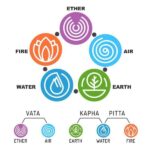Nidan in Ayurveda: Truths That Will Improve Your Health Instantly
Introduction: Understanding Nidan in Ayurveda
In Ayurveda, Nidan refers to the science of diagnosis—understanding the root cause of diseases, rather than merely treating symptoms. The word Nidan comes from Sanskrit, meaning “to investigate” or “to find the root cause.”
- Introduction: Understanding Nidan in Ayurveda
- 📜 History of Nidan
- 🕰️ Timeline of Nidan
- 🌟 Core Concepts of Nidan
- 1. Nidana (Cause)
- 2. Purvarupa (Early Symptoms)
- 3. Rupa (Manifest Symptoms)
- 4. Upashaya (Therapeutic Tests)
- 5. Samprapti (Pathogenesis)
- ✅ Interesting Facts About Nidan
- 🌿 Significance of Nidan in Health
- 🌞 Observance and Application of Nidan
- 🙏 Wishing With Nidan Wisdom
- 🔍 FAQs About Nidan
- ⭐ Review Section – Public & Expert Opinions
- 🌿 Daily Life Impact
- 📌 Important Points
- 🌍 Importance to Society
- 🌟 Conclusion
Unlike modern medicine, which often focuses on symptomatic relief, Nidan emphasizes holistic investigation, considering body, mind, spirit, lifestyle, and environmental factors. It is a vital pillar of Ayurveda, essential for effective treatment and maintaining long-term health.
In this article, we explore Nidan’s history, concepts, timeline, facts, significance, daily life applications, FAQs, review section, and societal importance, presented in a human-friendly manner.
📜 History of Nidan
Vedic Origins (1500–1000 BCE): Ayurvedic diagnosis evolved alongside early mentions of herbs, doshas, and diseases in the Atharvaveda.
Charaka Samhita (1000 BCE): Charaka emphasized Nidana Panchaka (five diagnostic criteria) for disease identification and management.
Sushruta Samhita (600 BCE): Focused on surgical diagnosis, wounds, and anatomical assessments.
Ashtanga Hridayam (500 CE): Vagbhata elaborated diagnostic methods including observation, palpation, and questioning.
Modern Recognition: Today, Nidan principles are integrated into Ayurvedic education, clinical practice, and global wellness programs.
🕰️ Timeline of Nidan
| Period | Key Development |
|---|---|
| 1500 BCE | Vedic texts mention disease identification methods |
| 1000 BCE | Charaka Samhita introduces Nidana Panchaka |
| 600 BCE | Sushruta Samhita integrates surgical diagnosis |
| 500 CE | Ashtanga Hridayam compiles holistic diagnostic techniques |
| 20th Century | Revival and standardization of Nidan in Ayurvedic colleges |
| 21st Century | Integration into global wellness and clinical research |
🌟 Core Concepts of Nidan
Nidan is based on understanding the root cause of illness through five primary diagnostic tools, collectively called Nidana Panchaka:
1. Nidana (Cause)
Identifies the origin or reason for the disease—could be lifestyle, diet, or environmental factors.
2. Purvarupa (Early Symptoms)
Recognizes subtle signs before full disease manifestation, allowing early intervention.
3. Rupa (Manifest Symptoms)
Observes clinical symptoms to confirm disease.
4. Upashaya (Therapeutic Tests)
Tests which interventions improve or worsen symptoms, guiding treatment.
5. Samprapti (Pathogenesis)
Analyzes the mechanism of disease progression, including dosha imbalance and organ involvement.
✅ Interesting Facts About Nidan
Nidan emphasizes root cause identification, not just symptom relief.
Charaka stated that proper Nidan ensures accurate diagnosis and successful treatment.
Nidan integrates physical, mental, and spiritual assessment.
Early recognition through Nidan can prevent chronic disease development.
Panchakarma therapies often rely on Nidan for personalized treatment planning.
Modern diagnostic tools in Ayurveda, like pulse reading (Nadi Pariksha), originate from Nidan principles.
Nidan principles are applicable even in modern preventive healthcare and lifestyle management.
🌿 Significance of Nidan in Health
Prevention: Early identification of imbalance prevents severe illnesses.
Personalized Care: Guides treatments based on individual dosha and constitution.
Holistic Approach: Considers physical, mental, and environmental factors.
Complementary Science: Integrates with modern diagnostics for better outcomes.
Educational Importance: Forms the backbone of Ayurvedic training and clinical practice.
🌞 Observance and Application of Nidan
Daily Self-Monitoring: Observing digestion, sleep, and energy levels to catch imbalances early.
Lifestyle Awareness: Noting the effects of diet, stress, and season on health.
Preventive Measures: Using herbs, oils, and therapies based on dosha assessment.
Therapeutic Testing: Trying dietary or lifestyle changes to see improvements in early symptoms.
Professional Consultation: Ayurvedic practitioners use Nidan for customized treatments.
🙏 Wishing With Nidan Wisdom
“May you always recognize the signs of imbalance early, take preventive action, and maintain harmony in body, mind, and spirit through the wisdom of Nidan.”
🔍 FAQs About Nidan
Q1: What is Nidan in Ayurveda?
It is the science of diagnosis and identifying the root cause of disease.
Q2: How is Nidan different from modern diagnosis?
Nidan emphasizes holistic evaluation including mental, environmental, and spiritual factors, not just lab tests.
Q3: What is Nidana Panchaka?
The five-step diagnostic tool: Nidana (cause), Purvarupa (early symptoms), Rupa (manifest symptoms), Upashaya (therapeutic tests), Samprapti (pathogenesis).
Q4: Can Nidan prevent disease?
Yes, early detection of imbalance allows preventive care and lifestyle adjustments.
Q5: Is Nidan still used today?
Yes, it is part of Ayurvedic education, clinical practice, and global wellness programs.
⭐ Review Section – Public & Expert Opinions
Patients’ Review: Many report better disease management after practitioners applied Nidan principles.
Doctors’ Perspective: Accurate Nidan ensures personalized, effective treatment.
Wellness Experts: Nidan principles enhance lifestyle guidance, nutrition, and preventive health.
Global Acceptance: Increasing interest in Nidan aligns with modern holistic and preventive medicine.
🌿 Daily Life Impact
Identifying subtle signs of imbalance (fatigue, indigestion, stress) early.
Preventing chronic diseases like diabetes, hypertension, and digestive disorders.
Improving mental clarity, energy, and emotional balance.
Guiding dietary choices based on dosha and constitution.
Supporting stress management and mental wellness.
📌 Important Points
Nidan = Root cause identification in Ayurveda.
Nidana Panchaka = Five steps of holistic diagnosis.
Early intervention prevents chronic disease and supports long-term health.
Considers body, mind, spirit, and environmental factors.
Forms the foundation for all Ayurvedic therapies and lifestyle guidance.
🌍 Importance to Society
Promotes preventive healthcare and reduces dependency on chemical medications.
Encourages self-awareness and proactive health management.
Strengthens the global credibility of Ayurveda through structured diagnostics.
Supports holistic public health strategies and community wellness.
Preserves the cultural and scientific heritage of India.
🌟 Conclusion
Nidan in Ayurveda is more than a diagnostic tool—it is a philosophy of proactive, holistic health. By understanding the root causes of imbalance and disease, we can prevent illness, restore harmony, and maintain long-term well-being.
Whether applied in daily life through diet, lifestyle, and mindfulness, or in clinical practice by trained practitioners, Nidan empowers individuals to take control of their health in a natural and sustainable way.
✨ May the wisdom of Nidan guide you toward a life of balance, vitality, and holistic wellness. 🌿








